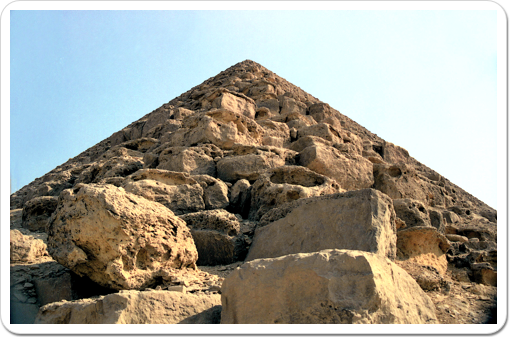Snofru, the first king of the 4th Dynasty, probably was the son of his predecessor Huni and Meresankh I, one of Huni’s secondary wives.
His marriage to his half-sister, Hetepheres I, appears to have legitimised his claim to the throne. Although the kings of the 4th Dynasty are thus descendants of the kings of the 3rd Dynasty, Manetho justifies his placing them in a separate dynasty because Snofru came from a different line in the royal family.
Next to Hetepheres, Snofru was married to at least two other but unknown queens, with whom he had several children. A first queen bore him several children, among whom Nefermaat, Rahotep and Ranofer.
Hetepheres I only seems to have born him one child, Kheops.
With a third wife, Snofru may perhaps only have had one or two children: Kanefer and Ankhaf.
Nefermaat and Rahotep were buried at the cemetery of Meidum, near the pyramid often wrongly credited to Huni. This seems to indicate that they were an older ‘generation’ of Snofru’s offspring, from before he moved to the newer burial grounds of Dashur, some 45 km to the North.
According to Manetho, the first king of the 4th Dynasty ruled for 29 years, but the Turin Canon (column 3, line 9) only credits him with 24 years. The Palermo Stone mentions a 6th to 8th cattle count, but is unfortunately fragmentary at this point. It does show, however, that the cattle counts during Snofru's reign were not always held at 2-year intervals, making it difficult to asses how long this king really ruled.
The highest year count that has been found for Snofru is his 24th, indicating a minimum rule of 24 years and a maximum of 49.
Still according to the Palermo Stone, Snofru organised an expedition to Lebanon to obtain the high quality cedar wood needed for the building of ships, holy barks and doors of palaces. He also ordered one or more military expeditions into Nubia, bringing back a large quantity of people and cattle and is believed to be the founder of the fortress Buhen, near the 2nd cataract in Nubia. Although his presence in the Sinai is no more unusual as that of his predecessors, he would later be worshipped as a god in this region.
His internal policy seems to have been aimed at maintaining royalty and the royal family. Most, but not all, of the high-placed officials and nobles at his court were members of his family. He was also responsible for rearranging the land ownership among his nobles, probably to prevent them from becoming too powerful but also to stimulate the cultivation of marshes.
The Meidum Pyramid is often credited to Huni, but it was at least completed or even completely built by Snofru.
It is generally believed that Snofru was responsible for the completion of his predecessor’s pyramid at Meidum, although there is no evidence at all of Huni's involvement in the building of that pyramid. It is therefor possible that Snofru built the pyramid at Meidum, as well two pyramids at Dashur. It is unknown why Snofru moved the location of the burial grounds to Dashur and not back to the more traditional Saqqara.
The angle of the sides of the southern pyramid at Dashur, believed by some to be the oldest of the two, was changed from 54°31 to 43°21 somewhere halfway the building, resulting in the unique shape of this so-called 'Bent Pyramid'. It has been argued that the angle was decreased in order to decrease the mass of the pyramid, fearing it would crumble otherwise, or in order to diminish the workload.
The northern pyramid is the first "true" pyramid, with an angle of 43°36. It is called the 'Red Pyramid' because of the colour its stones reflect at sunset. The fact that it has almost the same angle as the top of the Bent Pyramid, has sustained the belief that the Bent Pyramid was the oldest of the two.

The Red Pyramid was the first fully geometrical pyramid. It owes its modern-day name to the red granite that was used to construct its core.
Snofru also became somewhat of a popular figure after his death. His monuments are mentioned in the Middle Kingdom story of Sinuhe and he himself is described as a wise and kind ruler in the story on the Westcar Papyrus.